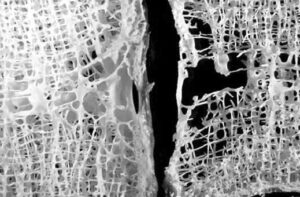Osteoporosis

What is Osteoporosis and Low Bone Density?
 Osteoporosis is a condition in which the bones become more porous, weak, and can break from a minor fall or, in serious cases, from a simple action such as a sneeze or bumping into furniture.
Osteoporosis is a condition in which the bones become more porous, weak, and can break from a minor fall or, in serious cases, from a simple action such as a sneeze or bumping into furniture.
Low bone density may mean that you have a greater chance of getting osteoporosis if you lose bone in the future. This is because you have less bone to lose.
If your bone density test shows you have low bone density or osteopenia, a fracture risk assessment tool called FRAX can help your health care provider estimate your chance of breaking a bone within the next 10 years. This makes it easier to decide whether you might benefit from taking an osteoporosis medicine.
-
Symptoms of Osteoporosis
-
 Osteoporosis is called the “silent disease” because bone loss occurs without symptoms. People may not know that they have osteoporosis until their bones become so weak that a sudden strain, bump, fall or even sneezing causes a fracture or a vertebra to collapse. Osteoporosis can be present over years without any noticeable symptoms, but signs can include:
Osteoporosis is called the “silent disease” because bone loss occurs without symptoms. People may not know that they have osteoporosis until their bones become so weak that a sudden strain, bump, fall or even sneezing causes a fracture or a vertebra to collapse. Osteoporosis can be present over years without any noticeable symptoms, but signs can include:- Severe back pain
- Loss of height
- Stooped posture
- Bone fractures from a minor injury
-
Common Risk Factors
-
Below is a list of common risk factors for osteoporosis:
- Gender – women are much more likely to develop osteoporosis than men
- Having a thin and/or small frame
- Advanced age – the older you get, the more increased risk of osteoporosis
- Family history of osteoporosis
- Ethnicity – you’re at greater risk of osteoporosis if you’re Caucasian or of Asian descent
- Low sex hormones – the reduction of estrogen levels at menopause is one of the strongest risk factors for developing osteoporosis. Lowered sex hormone levels tend to weaken bones
- Post menopause, including early or surgically-induced menopause
- Abnormal absence of menstrual periods
- Eating disorders or weight-loss surgery
- A diet low in calcium
- Use of certain medications such as steroids
- Thyroid problems
- Low testosterone in men–men experience a reduction in testosterone levels as they age and some treatments for prostate cancer reduce testosterone levels in men
- Inactive lifestyle
- Cigarette smoking
- Excessive use of alcohol
-
Prevention
-
Help reduce your risk of osteoporosis by incorporating the following steps into everyday life:
- Building strong bones during childhood and adolescence can be the best defense against developing osteoporosis later
- Be sure to get enough calcium and vitamin D every day
- Eat a balanced diet with plenty of fruits and vegetables
- Do regular weight-bearing and muscle-strengthening exercises
- Be careful with salt, caffeine and cola drinks — too much is not good for your bones
- Avoid excessive use of alcohol; more than 2-3 drinks a day can harm your bones
- Live a healthy, non-smoking lifestyle
Talk to your health care provider about your risk of developing osteoporosis or low bone density, and ask when you should schedule a bone density exam.
Resources
Below are additional resources for more information about osteoporosis:
Government institute providing information on osteoporosis including bone health, bone density tests, nutrition, exercise, healthy lifestyles, medication and more. They also have some information about the link between osteoporosis and breast cancer.
National Osteoporosis Foundation
The nation’s leading voluntary health organization solely dedicated to osteoporosis and bone health.
A non-profit foundation that promotes and supports strong bone health in children, teenagers, youth, and young adults, thereby preventing osteoporosis in later life. Its expanded mission is to help find a cure for osteoporosis in young adults under age 40.
